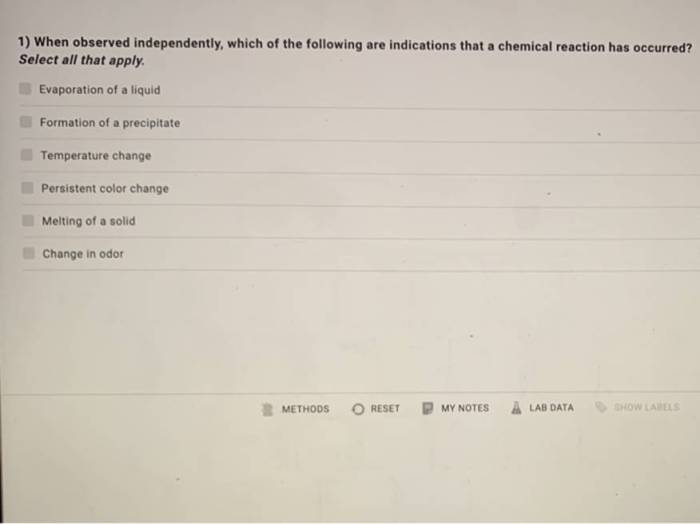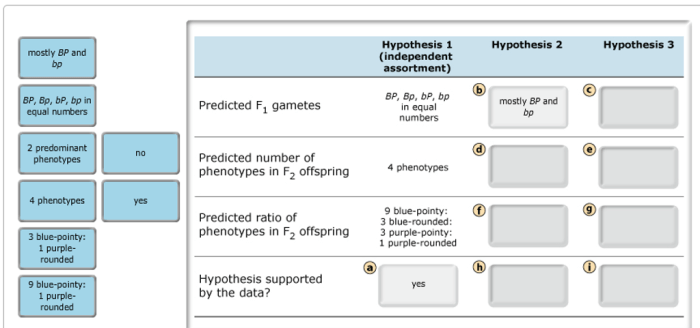When observed independently which of the following are indications – When observed independently, certain phenomena can serve as indications of underlying factors, patterns, or relationships. This concept lies at the heart of scientific inquiry and everyday decision-making, as we seek to discern meaning from the myriad observations we encounter.
From correlations and symptoms to patterns and trends, this discussion delves into the nuances of interpreting observed data and the significance of establishing causation, diagnosis, and prediction.
Correlation vs. Causation

Correlation and causation are two distinct concepts often confused in research and everyday life. Correlation refers to a statistical relationship between two or more variables, indicating that they change together. Causation, on the other hand, implies that one variable directly causes the change in another.
Observing a correlation independently does not necessarily indicate causation. For example, a correlation between ice cream sales and drowning rates might suggest a causal relationship, but it is more likely due to a third factor, such as warm weather, which increases both ice cream consumption and swimming activity.
Establishing causation requires demonstrating that the change in one variable consistently leads to a change in the other, excluding alternative explanations. This typically involves controlled experiments, where one variable is manipulated while others are held constant.
Symptoms vs. Diagnosis
Symptoms are observable signs or sensations that indicate a potential health issue. Diagnosis refers to the identification of a specific disease or condition based on these symptoms and other relevant information.
Observing symptoms independently can sometimes indicate a diagnosis. For example, fever, cough, and sore throat may strongly suggest a respiratory infection. However, it is important to consider other factors, such as the patient’s medical history and physical examination, to confirm the diagnosis.
Some symptoms are highly specific to certain diseases, while others are common to multiple conditions. Accurate diagnosis requires careful evaluation of all available information.
Patterns vs. Trends, When observed independently which of the following are indications
Patterns are recurring sequences or arrangements of data points. Trends are long-term changes or developments in data over time.
Identifying patterns and trends in observed data is crucial for understanding and predicting future events. Statistical techniques, such as time series analysis, can be used to detect patterns and trends in data.
Recognizing trends is particularly important for decision-making and forecasting. By identifying trends, we can anticipate future changes and make informed decisions accordingly.
Coincidence vs. Recurrence
Coincidence is an event that occurs by chance, while recurrence is an event that happens repeatedly.
Determining whether an observed event is a coincidence or a recurrence depends on its probability and the number of times it has occurred. If an event has a low probability of occurring and has happened only once, it is likely a coincidence.
However, if an event has a high probability of occurring and has happened multiple times, it is more likely a recurrence.
Recurring events may indicate underlying patterns or factors that need to be investigated to understand the underlying causes.
Association vs. Dependency
Association refers to a relationship between two or more variables that occur together more often than expected by chance. Dependency, on the other hand, implies that one variable is dependent on another.
Observing an association independently can sometimes indicate dependency. For example, an association between smoking and lung cancer suggests that smoking may increase the risk of developing lung cancer.
However, it is important to consider other factors and conduct further research to establish dependency. Just because two variables are associated does not necessarily mean that one causes the other.
Similarity vs. Identity
Similarity refers to the degree to which two or more entities share common characteristics. Identity, on the other hand, implies that two entities are exactly the same.
Assessing the degree of similarity between observed entities is important for classification and understanding. Techniques such as cluster analysis and discriminant analysis can be used to identify similarities and differences between entities.
Distinguishing between similarity and identity is crucial for accurate classification and understanding the relationships between different entities.
Query Resolution: When Observed Independently Which Of The Following Are Indications
What is the difference between correlation and causation?
Correlation refers to a relationship between two variables, while causation implies that one variable directly influences the other.
How can observing symptoms independently indicate a diagnosis?
Specific symptoms can be strong indicators of certain diseases, allowing healthcare professionals to make informed diagnoses.
What is the significance of recognizing trends for prediction?
Identifying trends in observed data enables us to make predictions about future events and patterns.

